Running an efficient online store requires seamless order fulfillment, and often that means upgrading to a 3rd-party logistics (3PL) provider. This outsourcing of the fulfillment process works by sending products to the 3PL, where they store, pick, package, and ship the items as orders come in through your store.
Two of the best 3PLs are ShipBob and Red Stag Fulfillment, so we want to compare ShipBob vs Red Stag Fulfillment for merchants to understand which one works best for them.

In this ShipBob vs Red Stag Fulfillment comparison, we look into several categories:
- The main differences between ShipBob vs Red Stag Fulfillment
- Fulfillment options
- Warehouse networks
- Shipping speeds, methods, and discounts
- Software offerings
- Pricing and fees
- Customer support

Keep reading our ShipBob vs Red Stag Fulfillment review for the most in-depth comparison of the popular fulfillment companies.
ShipBob vs Red Stag Fulfillment: The Main Differences
- ShipBob has a larger network of fulfillment centers
- Red Stag Fulfillment has no international (non-US) fulfillment centers, while ShipBob has several (but Red Stag still provides shipping overseas)
- Both Red Stag and ShipBob integrate with the top ecommerce platforms like Shopify, WooCommerce, and Bigcommerce, but vary with others: like how ShipBob integrates with Squarespace, but Red Stag doesn’t, or how Red Stag integrates with Magento and ShipBob doesn’t—however, both allow for custom integrations
- Both 3PLs have marketplace integrations, like for eBay, Walmart, and Amazon
- Red Stag has same-day, 1-day, and 2-day fulfillment options, while ShipBob primarily sticks to a 2-day schedule
- ShipBob offers shipping methods and discounts for UPS, USPS, FedEx, and DHL; Red Stag’s discounts and methods are through FedEx, UPS, USPS, OnTrac, and Amazon
- Returns are offered through ShipBob for a fee; Red Stag handles returns as well, also for a fee
- Red Stag’s storage (bin and pallet) fees are far cheaper than ShipBob’s, but ShipBob ties receiving, picking, and packing into the overall cost, whereas Red Stag charges separately for those
- For customer support, ShipBob offers a phone line, email, chat, and knowledgebase; Red Stag Fulfillment has much of the same, minus the chat
Fulfillment Options: ShipBob vs Red Stag Fulfillment
When analyzing fulfillment options, we’re looking into the types of services offered by each 3PL. This is particularly important for ecommerce brands with specific needs such as Amazon fulfillment, cold storage, or omnichannel fulfillment.
For example, you may require kitting and realize that only some fulfillment companies provide kitting, so the other aspects like pricing and speed become less influential. That’s why it’s essential to find out if 3PL actually offers the type of storage and fulfillment you’ll need before anything else.
ShipBob Fulfillment Options
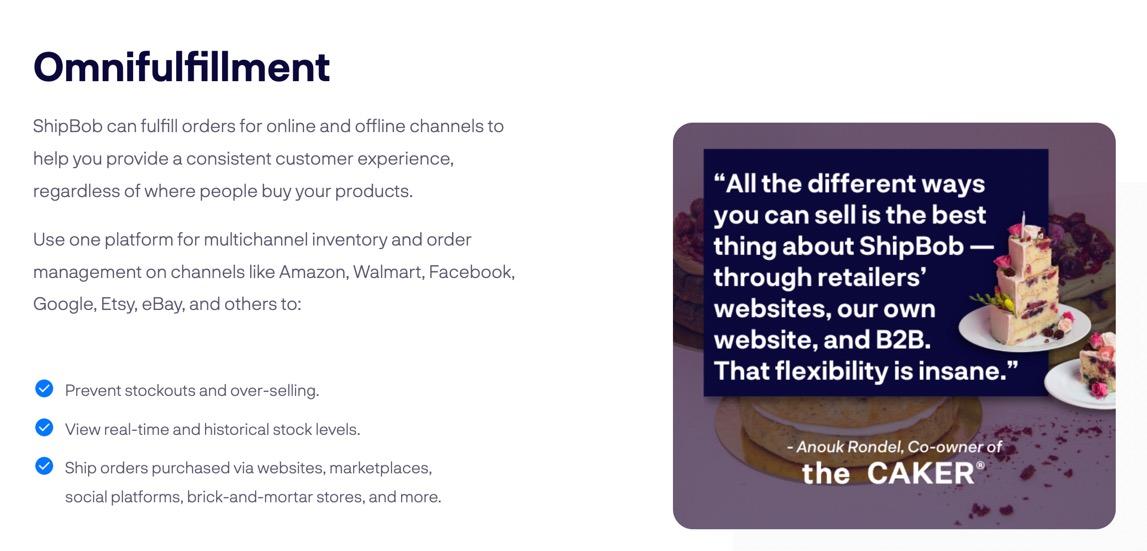
ShipBob caters to ecommerce brands that require standard storage and fulfillment, along with fast shipping to customers. However, they do provide some unique fulfillment methods if necessary. Here’s the current list of fulfillment methods available from ShipBob:
- Standard ecommerce order fulfillment
- Omnichannel fulfillment (for fulfilling sales on multiple marketplaces, like Amazon and eBay)
- Subscription fulfillment
- B2B fulfillment
- Global fulfillment
- Kitting
- Custom packaging and inserts
- FDA-certified food product handling
ShipBob states that this list is longer, so you may need to contact them for any special requirements. It’s possible some of their facilities accommodate unique situations, like for cold storage.
Red Stag Fulfillment Options
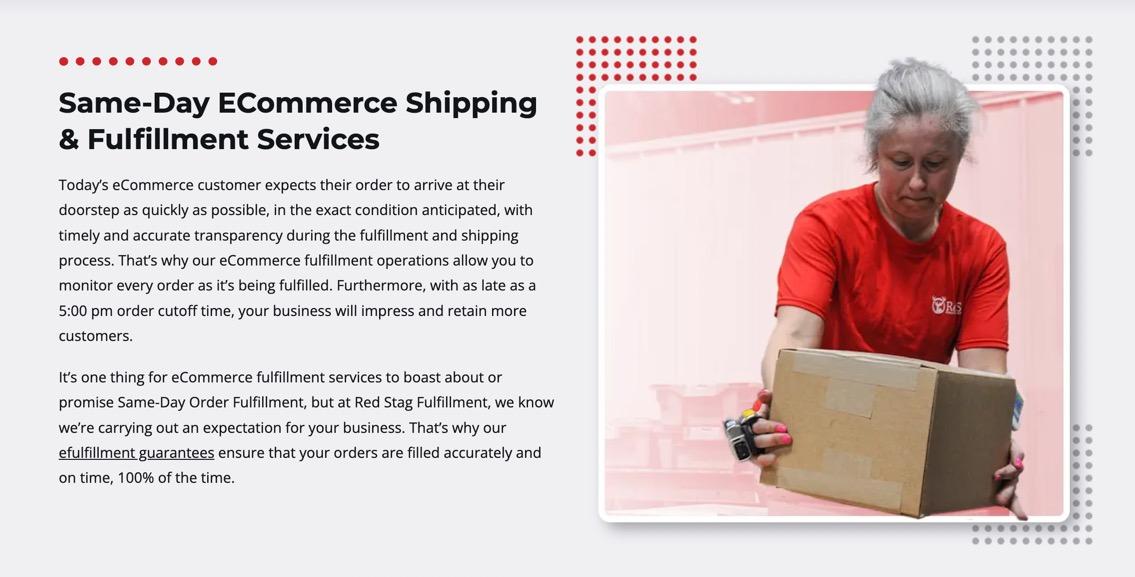
Red Stag stands out as an ecommerce fulfillment service due to its options for standard and unique fulfillment options. You could opt for simple warehousing, complete order fulfillment, or omnichannel fulfillment based on your needs.
Here are the offerings from Red Stag:
- Standard ecommerce fulfillment
- Omnichannel fulfillment
- Inventory planning
- Warehousing services
- Kitting and assembly
- Cold storage
- Handling food items
- Heavy and oversized good fulfillment
- Fragile and high-value merchandise fulfillment
- Hazmat shipping
- CBD fulfillment
Our conclusion:
ShipBob is best for high-volume sellers with small to mid-sized products that aren’t that unique (fragile, heavy, expensive, etc.) Red Stag is sufficient for standard ecommerce shipping, but also excels with unique fulfillment needs like heavy products, fragile items, and kitting.
Warehouse Networks: ShipBob vs Red Stag Fulfillment
A larger warehouse network (more warehouses) gets you closer to the customer. As a result, you should see faster shipping speeds and lower shipping rates. However, larger warehouse networks could lead to a more confusing infrastructure, lack of quality control, and less transparency as to where your products are located.
ShipBob Warehouse Network

The ShipBob corporate headquarters is in the heart of Chicago, but most of its fulfillment center locations are in suburban or rural locations, spread all around the country. In addition, ShipBob boasts warehouses in multiple other countries.
Here’s the list:
- Cicero, IL
- Woodridge, IL
- Yorkville, IL
- Louisville, KY
- Geneva, WI
- Budd Lake, NJ
- Edison, NJ
- Bethlehem, Pennsylvania (2 warehouses here)
- Gouldsboro, Pennsylvania
- Atlanta, Georgia
- Chattanooga, TN
- Carrollton, TX
- Farmers Branch, TX
- Grapevine, TX (2 locations here)
- Phoenix, AZ
- Moreno Valley, CA
- Laz Vegas, NV
- Hillsboro, OR
- Melbourne, Australia
- Ottawa, Canada
- Toronto, Canada
- Western Poland, Europe
- Heywood, UK (nearby Manchester)
- Birmingham, UK
- Dublin, Ireland
Red Stag Warehouse Network

The Red Stag fulfillment center network is significantly smaller than ShipBob’s. However, they make up for it with efficient fulfillment protocols, large warehouses, and strategic locations for rapid shipments to just about every area in the US.
Here are Red Stag’s warehouse locations:
- Knoxville, TN
- Salt Lake City, UT
Our conclusion:
With a total of 27 warehouse locations (7 of which are in countries outside the US), ShipBob clearly has the stronger fulfillment network. Red Stag still offers international fulfillment, but ShipBob is definitely the global provider. However, Red Stag has a more efficient operation, casting a smaller footprint and providing 1-2 day fulfillment to most of the US, due to its intentional locations in Utah and Tennessee. They have access to every region, and the further reaches of the lower 50 states max out at around 3-5 day shipping, but that’s rare. Not to mention, Red Stag still provides fast Canadian shipping.
Shipping Speeds, Methods, and Discounts: ShipBob vs Red Stag Fulfillment
When partnering with a 3PL, they usually get bulk shipping discounts from major carriers like FedEx, UPS, USPS, and DHL. You benefit from those relationships, even though you may not have the order volume to receive these types of discounts. We also want to look into the shipping methods and speeds from ShipBob and Red Stag, since that decides how fast customers get your products.
ShipBob Shipping

ShipBob partners with these carriers for various shipping methods and discounts:
- UPS
- USPS
- FedEx
- DHL
- Some regional carriers like Canada Post
The shipping times vary based on the shipping method and destination, but here’s what we’ve found:
- Standard 2-day shipping to most of the US
- ShipBob uses Canada Post from its Canadian centers, which delivers in 2-4 days for most customers in Canada.
- European delivery times range from 2-5 days. There’s an expedited option for 1-3 days.
- Australian shipping times are 1-7 business days.
Red Stag Shipping
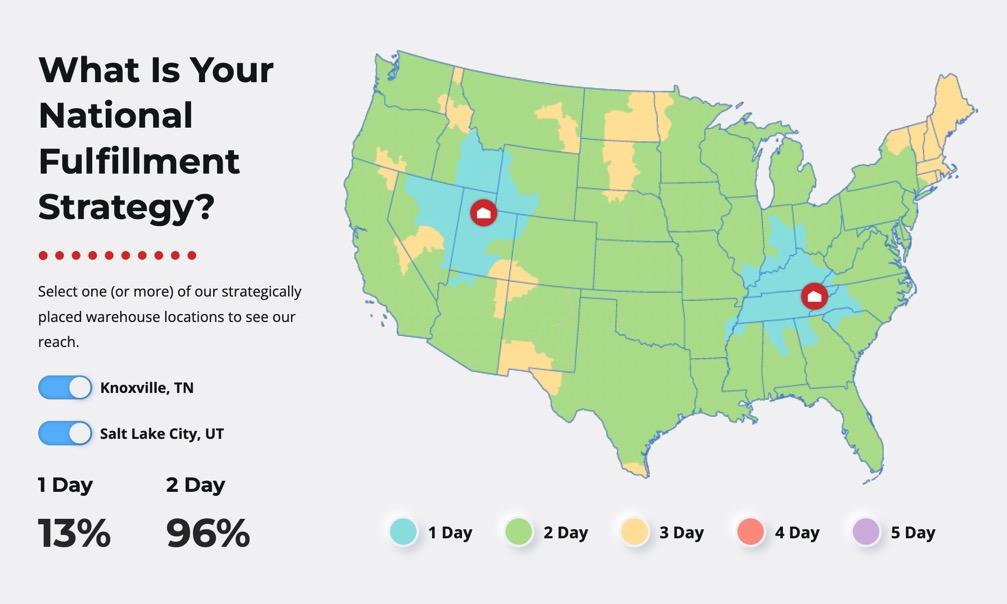
Red Stag’s discounts and methods are through:
- FedEx
- UPS
- USPS
- OnTrac
- Amazon
Here are the shipping times:
- Same-day and 1-day shipping options to 13% of the US, mainly near the Tennessee and Utah fulfillment centers
- 2-day shipping to 96% of the US
- 3-5 day shipping to the rest of the US, mainly small pockets like the southern tip of Texas, most of Maine, and parts of North Dakota.
- International shipping options through the Tennessee location, which links to the New York and New Jersey ports (Red Stag uses the USPS international shipping methods for this)
Our conclusion:
Surprisingly, Red Stag Fulfillment offers a stronger guarantee of faster shipping speeds throughout the United States. Some customers can choose same-day and 1-day shipping, and the standard is 2-day shipping, with a maximum of around 5 days. ShipBob’s 2-day guarantee is pretty solid though, and it’s definitely the right choice for international shipping, due to their global carrier partnerships and larger warehouse network.
Software Offerings: ShipBob vs Red Stag Fulfillment
The best 3rd-party logistics companies provide robust software suites for managing everything from warehouse designations to the movement of your inventory from the warehouse to customers. The software should also integrate with popular ecommerce platforms and marketplaces.
ShipBob Software
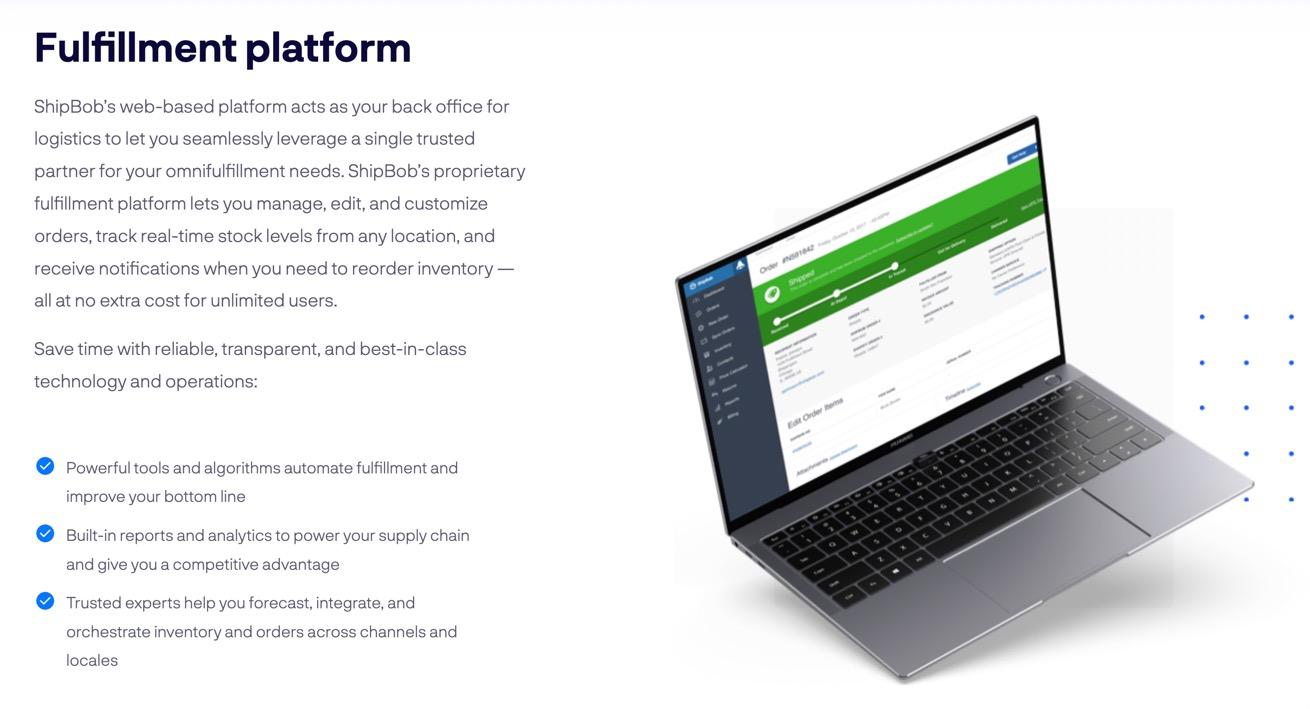
ShipBob’s software provides:
- Inventory management
- Order management
- Inventory distribution
- Reporting and analytics
- Stock level notifications
- Automated fulfillment when linked to your ecommerce platform
It all starts with the inventory management module, where ShipBob’s software tracks the location of all inventory, allows you to analyze storage costs, and figure out which products perform the best. The order management features allow for fulfillment processing, with everything you need to view or change statuses from “picked” to “fulfilled.” You can also find relevant shipping information like carrier services and dimensions within the ShipBob suite.
ShipBob integrates with a wide range of systems. And there’s always the possibility to tap into its API. However, we’re more keen on the built-in integrations, seeing as how that requires minimal work on the merchant’s end.
Here are some of the ShipBob integrations with ecommerce platforms:
- Shopify
- Shopify Plus
- Bigcommerce
- WooCommerce
- Squarespace
- Wix
- Square
Beyond standard ecommerce platforms, ShipBob also integrates with several marketplaces for multichannel fulfillment, such as:
- Amazon
- Ebay
- Walmart
- Backerkit (for crowdfunding)
Finally, the ShipBob software integrates with a myriad of other tools, ranging from return portals to custom design solutions, and ecommerce marketing software to customer relationship management tools.
Red Stag Software
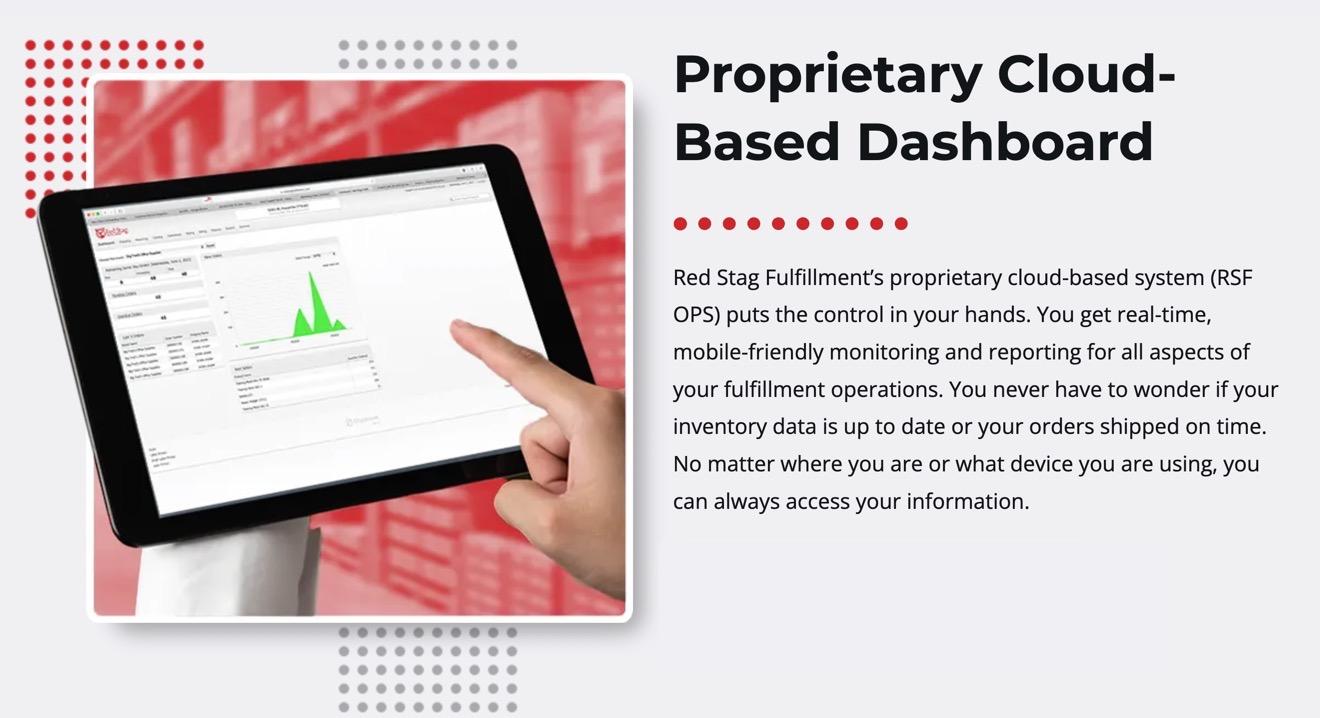
Merchants receive a robust fulfillment software once they sign up for any logistical service from Red Stag Fulfillment.
The proprietary cloud-based software has modules for:
- Inventory management
- Order management
- Inventory and order tracking
- Insights and forecasts
- Warehouse management
- Stock level notifications
- Integrations with popular ecommerce platforms
Some of the ecommerce platforms that integrate with Red Stag’s software include:
- Shopify
- Magento
- WooCommerce
- Bigcommerce
- OpenCart
- Ecwid
- Shift4Shop
- PrestaShop
- Volusion
Although not always directly integrated, Red Stag offers links to marketplaces via third-party plugins or prebuilt integrations. If all else fails, you can turn to the Red Stag API. Notable 3rd party integrations include:
- Amazon
- Ebay
- Etsy
- Walmart
And, of course, Red Stag’s software has the ability to integrate with your favorite shipping and carrier services, along with several enterprise tools for return management and customer relationship management.
Our conclusion:
ShipBob wins when it comes to its overall quantity of integrations, particularly for marketplaces and business software. However, your choice may depend entirely on which ecommerce platform integrates easiest with each 3PL.
For instance, we’d recommend leaning towards ShipBob if you use Squarespace, Wix, or Square. It makes sense to go with Red Stag if using Magento, OpenCart, Ecwid, Shift4Shop, PrestaShop, or Volusion. Finally, all Shopify, Bigcommerce, and WooCommerce users will have no problem integrating with either 3PL.
Pricing and Fees: ShipBob vs Red Stag Fulfillment
When comparing ShipBob vs Red Stag Fulfillment pricing, it’s clear they have different structures. ShipBob charges more of an all-in-one fee for each product fulfilled, but that fee looks much higher than Red Stag’s because Red Stag breaks each service fee down individually. On the other hand, it initially looks like ShipBob offers free picking, packing, and receiving, but when you look closer, they’re actually just looped into the overall price.
With that said, keep reading to understand pricing for ShipBob vs Red Stag Fulfillment, and to figure out which is most cost-effective for your online store.
ShipBob Pricing and Fees
You can only find your true pricing for ShipBob by contacting the company and receiving a quote. However, ShipBob does provide base prices and sample fulfillments to give you an idea of what to expect.
As mentioned, ShipBob has several services listed as “free” or “included,” meaning that they’re not really free, but wrapped into the standard ecommerce fulfillment rate.
Here’s a look into the starting rates for standard ecommerce fulfillment (based on an example of supplements as the product):
- Picking and packing: Included
- Storage per bin: $5 per month
- Storage per shelf: $10 per month
- Storage per pallet: $40 per month
- Estimated average fulfillment cost for each order: $5.38 to $5.91
We could also look at the pricing for apparel, which factors in heavier, and potentially larger, packages:
- Receiving: Included
- Picking and packing: Included
- Storage per bin: $5 per month
- Storage per shelf: $10 per month
- Storage per pallet: $40 per month
- Estimated average fulfillment cost for each order: $6.13 to $7.23
Red Stag Pricing and Fees
Similar to ShipBob, Red Stag offers perks like discounted shipping rates, standard packaging materials, expert support, and its software with your merchant membership.
However, it’s pricing breakdown for storage and fulfillment is a bit more itemized, which, actually, provides more transparency.
Here’s a look:
- Receiving: $13.25 for every pallet received
- Picking and packing: $1 to pick and package the first item; $0.30 for every extra item after that in an order
- Storage per bin: $1 per month
- Storage per shelf: Included
- Storage per pallet: $15 per month
Red Stag doesn’t list any estimated average shipping costs per order, but it’s clear that its storage fees are significantly lower than ShipBob’s. However, you must factor in receiving and picking and packing fees, considering they’re included in the overall cost for ShipBob.
We know that the Red Stag picking and packing fee of $1 is pretty low, but an operation with significant receiving fees could see prices increase drastically.
Our conclusion:
Keep in mind that speciality storage and fulfillment services like subscriptions, kitting, cold storage, and large items require extra fees from both ShipBob and Red Stag Fulfillment. You’ll also have to pay additional fees for returns, regardless of your 3PL.
Our analysis shows that your fulfillment rates depend entirely on the size and type of product, along with receiving costs required. For instance, you would most likely save money with Red Stag if you can keep receiving fees down, while also shipping more one-product packages. However, ShipBob’s all-in-one pricing structure is hard to beat when it comes to simplicity. We’re just a little worried about its overpriced bins, shelves, and pallets when compared to Red Stag.
Customer Support: ShipBob vs Red Stag Fulfillment
Customer support means more for order fulfillment than perhaps any other software or service you use for your online business. Fulfillment is how your products get to customers, so you want a direct link to the people managing that supply chain; it helps to have detailed documentation, as well, for the software being used for inventory management.
In this section, we compare ShipBob vs Red Stag Fulfillment for their customer support offerings such as direct merchant assistance, online resources, and extras like blogs and social media pages.
ShipBob Customer Support

ShipBob users receive access to a private online portal where they can log into their accounts, gain access to customer support, manage inventory, and check out resources for everything from the API to the order management module.
As for direct human support, ShipBob offers:
- A phone line for technical, sales, and fulfillment support (9AM-5PM CST, Monday through Friday)
- An email and ticketing system (they reply to emails within 2 business days)
- A Help (chat) button on the merchant dashboard to access the Merchant Care team
Besides that, ShipBob provides self-research documentation online—and alternative means of contact—through:
- A Help Center with hundreds of articles
- A blog with guides on marketing, fulfillment, shipping, and more
- Developer and API documentation
- Social media pages on LinkedIn, Facebook, Twitter, and YouTube
Red Stag Customer Support
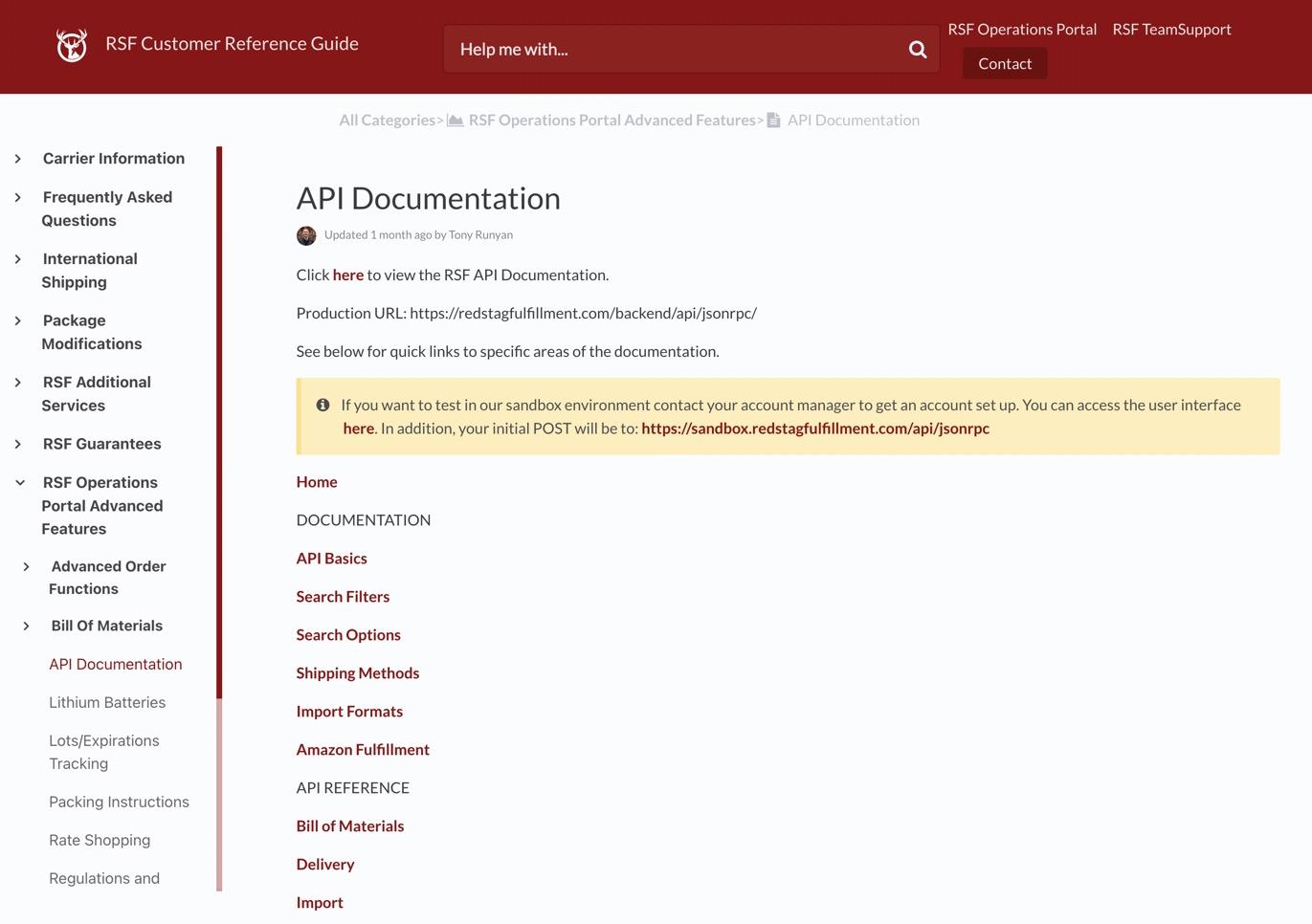
The Red Stag customer support is known for its responsiveness, knowledge, and ability to connect with merchants on a more personalized level due to its smaller warehouse network. That makes sense, considering you’ll be speaking with someone who only has to worry about your products inside two warehouses, instead of them being scattered across dozens of warehouses, potentially around the globe.
When it comes to direct (human) support methods, Red Stag Fulfillment offers:
- A phone line to speak with a person about inventory, fulfillment, sales, or general questions
- An email and ticketing system to get a response to questions within 24 hours
- An online portal for all Red Stag users to check on inventory, view reports, and tap into the customer support resources
And here are the additional support resources and communication channels from Red Stag:
- An online knowledgebase filled with documentation about carriers, FAQs, shipping, package modifications, and more
- A developer and API documentation section
- A blog with articles about integrations, fulfillment strategies, carrier choices, and more
- Ebooks and online documentation with case studies, calculators, dropshipping information, a fulfillment glossary, and more
- Social media pages on Facebook, Twitter, LinkedIn, and YouTube
Our conclusion:
The direct customer support options from both ShipBob and Red Stag are superb. You can contact either company through the phone or email, and each of them has an online portal for merchants to reach out to customer support reps. It’s unclear what the support hours are for Red Stag, but ShipBob is limited to certain business hours in the Central Time Zone.
We’re fond of the Red Stag support since it’s easier to find inventory management solutions (their warehouse network is smaller, so it’s a less complicated process). However, the ShipBob customer support team has proven they’re knowledgeable, friendly, and responsive enough to make any merchant feel comfortable about using their services.
Other than that, the documentation from each 3PL looks sufficient, and you can always access articles and videos for the API.
ShipBob vs Red Stag Fulfillment: Which is Right for Your Ecommerce Store?
It’s tough to make a decision between ShipBob vs Red Stag fulfillment without actually contacting both for demos and estimates. However, we hope this analysis provides you enough information to get a feel for each 3PL and where they primarily excel.
Based on our ShipBob vs Red Stag Fulfillment review, here are some final thoughts:
- Fulfillment options: ShipBob is best for standard ecommerce fulfillment, especially high-volume merchants with fairly “normal” products. We recommend Red Stag for standard fulfillment as well, but they really excel when you need unique fulfillment requirements; think cold storage, large products, fragile items, subscriptions, and Amazon-fulfilled operations.
- Shipping speed, methods, and discounts: You get discounts from both. ShipBob appears to work with more carriers, which gives you additional choices. The US shipping speeds, however, appear faster through Red Stag. Having said that, there’s no beating ShipBob in the international shipping game.
- Software offerings: Both 3PLs offer powerful software for inventory, warehouse, order, and return management. You also get reports and analysis regardless of the 3PL. However, the integrations are different. For instance, Volusion, Magento, and OpenCart users can integrate with Red Stag, while Wix, Squarespace, and Square users can integrate with ShipBob. They both integrate with Shopify, Bigcommerce, and WooCommerce.
- Pricing and fees: A personalized quote from each 3PL is a must. What we do know is that ShipBob has more of an all-in-one pricing model where receiving and packing is included, but the storage costs are far more expensive. Red Stag, on the other hand, has significantly lower storage fees, but you must pay for other things separately, like receiving.
- Customer support: This is pretty much a tie. They both offer quality online resources, phone and email support, along with dedicated customer support teams. However, you may find it easier to get answers about specific inventory movements with the smaller warehouse network from Red Stag Fulfillment.
That’s all we have for our ShipBob vs Red Stag Fulfillment comparison and review! Please let us know in the comments section if you have any further questions about the two popular 3PLs. And also share your thoughts if you have experience using either of them for your ecommerce fulfillment.




Comments 0 Responses